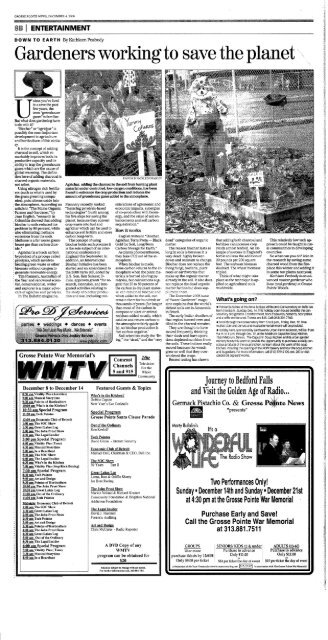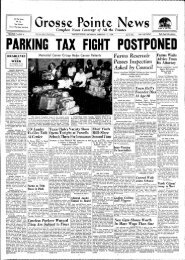You also want an ePaper? Increase the reach of your titles
YUMPU automatically turns print PDFs into web optimized ePapers that Google loves.
GROSSE POINTE NEWS, DECEMBER 4, 2008<br />
ENTERTAINMENT<br />
DOWN TO EARTH By Kathleen Peabody<br />
Gardeners working to save the planet<br />
"• f •Vy.Vi iYt'-VA ***** ' * V<br />
fc<br />
' *<br />
"nless you've lived<br />
in a cave the past<br />
few years, the<br />
term "greenhouse<br />
gases" is familiar.<br />
, But what does gardening have<br />
to do with it?<br />
"Biochar" or "agricjiar" is<br />
possibly the most important<br />
development in agriculture<br />
' and horticulture of this century-<br />
It is the concept of adding<br />
charcoal to soil, which remarkably<br />
improves both its<br />
productive capacity and its<br />
' ability to trap the greenhouse<br />
' gases which are the cause of<br />
* global warming. The defini-<br />
* tion here of adding charcoal is<br />
charred organic materials,<br />
not ashes.<br />
Using nitrogen rich fertiliz-<br />
; ers (such as what's used by<br />
the grass greening companies),<br />
puts nitrous oxide into<br />
the atmosphere. According an<br />
' article in "The Maine Organic<br />
' Farmer and Gardener," by<br />
! Jean English, "research in<br />
. Colombia showed that adding<br />
; biochar to soils reduced the<br />
; problem by 80 percent, while<br />
; also eliminating methane<br />
emissions from the soils.<br />
< Methane is a far worse green-<br />
* house gas than carbon diox-<br />
: ide."<br />
I Agrichar is a black carbon<br />
'. byproduct of a process called<br />
: pyrolysis, which involves<br />
! heating green waste or other<br />
; biomass without oxygen to<br />
* generate renewable energy.<br />
* Tim Flannery, Australian of<br />
\ the Year and renowned scientist,<br />
conservationist, writer<br />
and explorer is a major advocate<br />
of agrichar and pyrolysis.<br />
In The Bulletin magazine,<br />
PHOTOS BY KA1<br />
Agrichai; adding the charcoal to the soil from bui<br />
material under controlled, low-oxygen conditions h.i<br />
found to enhcance the crop production and reduce-, it<br />
amount of greenhouse gases added to the atmosphi'i t<br />
Flannery recently ranked<br />
"fostering pyrolysis-based<br />
technologies" fourth among<br />
his five steps for saving the<br />
planet, because they convert<br />
crop waste into fuel and<br />
agrichar which can be used to<br />
enhance soil fertility and store<br />
carbon long-term.<br />
The concept of using<br />
biochar holds such promise it<br />
is the sole subject of an international<br />
conference in<br />
England this September. In<br />
addition, an International<br />
Biochar Initiative has been<br />
started and an amendment to<br />
the 2008 Farm Bill, added by<br />
U.S. Sen. Ken Salazar, D-<br />
Colo. approves grants "for research,<br />
extension, and integrated<br />
activities relating to<br />
the study of biochar production<br />
and use, including conparties<br />
• weddings • dances • events<br />
Grosse Pointe s D<br />
313.884.0130<br />
Grosse Pointe War Memorial's<br />
December 8 to December 14<br />
8:30 am Vitality Plus (Aerobics)<br />
9:00 am Musical Storytime<br />
9:30 am Pointes of Horticulture<br />
10:00 am Who's in the Kitchen?<br />
10:30 am Special Program<br />
11:30 am Tech Pointes<br />
12:00 pm Economic Clab of Detroit<br />
1:00 pm The SOC Show<br />
l:30.pm.Great Lakes Log<br />
2:00 pm The John Prost Show<br />
2:30 pm The Legal Insider<br />
3:00 pm Special Program<br />
4:00 pm Vitality Plus (Tone)<br />
4:30 pm Musical Storytime<br />
5|00 i<br />
pm i<br />
l.n a Heartbeat<br />
5:30 pm The SOC Show<br />
6:00 pm The Legal Insider<br />
6:30 pm Who's in the Kitchen<br />
7:00 pm Vitality Plus (Step/Kick Boxing)<br />
7:30 pm Special Program<br />
8:30 pm Tech Pointes<br />
9:00 pm Art and Design<br />
9:30 pm Pointes of Horticulture<br />
10:00 pm The John Prost Show<br />
10:30 pm Great Lakes Log<br />
ll:Q0 i<br />
pm ii<br />
Out of the Ordinary<br />
11:30 pm Tech Pointes<br />
Midnight Economic Club of Detroit<br />
1:00 am The SOC Show<br />
1:30 am Great Lakes Log<br />
2:00 am The John Prost Show<br />
2:30 am Tech Pointes<br />
3:00 am Art and Design<br />
3:30 am Pointes oPHorticulture<br />
4:00 am The John Prost Show<br />
4:30 am Great Lakes Log<br />
5:00 am Out of the Ordinary<br />
5:30 am The Legal Insider<br />
6:00 am Special Program<br />
7:00 am Vitality Plus ( Tone)<br />
7:30 am Musical Storytime<br />
8:00 am In a Heartbeat<br />
siderations of ag:<br />
economic impact<br />
of co-production<br />
ergy and the vali<br />
hancements and<br />
sequestration."<br />
1<br />
•-. ht><br />
How it works<br />
English writes in "Biochar,<br />
Agrichar, Terra Preta—Black<br />
Gold for Soil, Long-Term<br />
Carbon Storage for Earth:"<br />
As plants photosynthesize,<br />
they take C02 out of the atmosphere.<br />
When biochar is made,<br />
some carbon returns to the atmosphere<br />
when the plant materials<br />
is burned (during pyrolysis),<br />
but calculations suggest<br />
that 20 to 50 percent of<br />
the carbon in dry plant material<br />
can remain in biochar and<br />
when added to the soil, can<br />
remain there for hundreds or<br />
thousands of years (far longer<br />
than most of the carbon in<br />
compost or plant or animal<br />
residues added to soils, which<br />
oxidize and return carbon to<br />
the atmosphere fairly quickly)<br />
, so biochar production is<br />
'net carbon negative.'<br />
Soil scientists study the "living,"<br />
the "dead," and the "very<br />
Comcast<br />
Channels<br />
5 and 915<br />
24hr<br />
Television<br />
For the<br />
Whole<br />
Community<br />
Featured Guests & Topics<br />
Who's in the Kitchen?<br />
Debbie Caputo<br />
New Year's Eve Cocktails<br />
Special Program<br />
Grosse Pointe Santa Clause Parade<br />
Out of the Ordinary<br />
Ron Kosloff<br />
Tech Pointes<br />
David Glenn - Internet Security<br />
Economic Club of Detroit<br />
Michael Dell, Chairman & CEO, Dell Inc.<br />
The SOC Show<br />
30 Years Part II<br />
Great Lakes Log<br />
Lome, Ron & Griffin Sherry<br />
Ice Boat Racing<br />
The John Prost Show<br />
Marion Noland & Richard Kramer<br />
Community Foundation & Brighton National<br />
Addiction Foundation<br />
The Legal Insider<br />
David J. Hammel<br />
Forensic Auditing<br />
Art and Design<br />
Chris McCarus - Radio Reporter<br />
A DVD Copy of any<br />
WMTV<br />
program can be obtained for<br />
$20<br />
Schedule subject to change without notice.<br />
For further information call, 313-88I-75U<br />
•* H i<br />
HHH|<br />
dead" categories of organic<br />
matter.<br />
The reason biochar lasts so<br />
long in soils is because it is<br />
very dead: highly broken<br />
down and resistant to change.<br />
Biochar does not replace the<br />
living fungi, bacteria, plant<br />
roots or earthworms that<br />
make up the organic matter<br />
already in the soil. It also does<br />
not replace the dead organic<br />
matter faction but does supplement<br />
them.<br />
The December 2008 issue<br />
of "Avant Gardener" magazine<br />
explains that the world's<br />
richest soils are in Amazonia<br />
in Brazil.<br />
The early Indian dwellers of<br />
that region burned trees and<br />
tilled in the charred remains.<br />
They are thought to have<br />
moved frequently thinking<br />
their slash-and-burn operations<br />
depleted nutrition from<br />
the soils. These Indians really<br />
moved because the weeds<br />
grew so well that they overwhelmed<br />
the crops.<br />
Recent testing has shown<br />
I<br />
that adding both charcoal and<br />
fertilizer can increase crop<br />
yields almost tenfold. An example<br />
of success in England's<br />
fertile soil was the addition of<br />
20 pounds per 200 square<br />
feet. The soybean biomass<br />
doubled. The wheat biomass<br />
tripled.<br />
Think of what might take<br />
place as the technique is applied<br />
on agricultural soils<br />
worldwide.<br />
!_ E
















